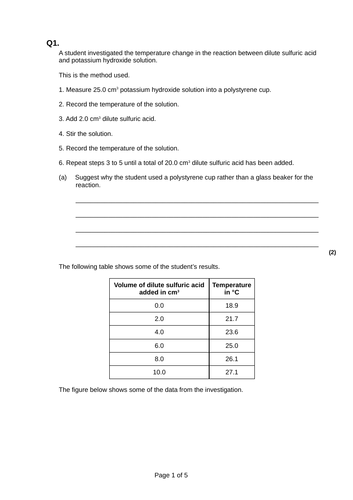
21Uploads
953Views
47Downloads
Chemistry

Year 7 - Boiling and Melting Points (particles) + stearic acid practical
changes of states
heating curves
pure vs impure
stearic acid melting experiment (melt the stearic acid in hot water, recording the temperature at different time intervals. Then plot a graph of the results.)
variables

AQA Paper 1 Chemistry past paper questions with answers in powerpoint
starter on concentration of solutions
various questions on paper 1 with answers as animations on ppt

C5 energy changes + practical + exam questions
Energy is conserved in chemical reactions. The amount of energy in the universe at the end of a chemical reaction is the same as before the reaction takes place. If a reaction transfers energy to the surroundings the product molecules must have less energy than the reactants, by the amount transferred. An exothermic reaction is one that transfers energy to the surroundings so the temperature of the surroundings increases. Exothermic reactions include combustion, many oxidation reactions and neutralisation. Everyday uses of exothermic reactions include self-heating cans and hand warmers. An endothermic reaction is one that takes in energy from the surroundings so the temperature of the surroundings decreases. Endothermic reactions include thermal decompositions and the reaction of citric acid and sodium hydrogencarbonate. Some sports injury packs are based on endothermic reactions. Students should be able to: • distinguish between exothermic and endothermic reactions on the basis of the temperature change of the surroundings • evaluate uses and applications of exothermic and endothermic reactions given appropriate information.

Introduction to electrolysis
Ions revision
Physical Properties of Ionic Compounds
exam questions
OILRIG equations

Covalent bonding/ simple molecules lesson with molymods
Bonding recap
questions/ answers
molymods practical
intramolecular forces
relative formula questions

Acids and alkalis: pH and Indicators/ neutralisation
universal indicator practical
evaluating methods of detecting pH
demo acids + alkalis and then use pH indicator
neutralisation practical (you will need 3-4 different types of indigestion tablets)
acid + alkali word equations







